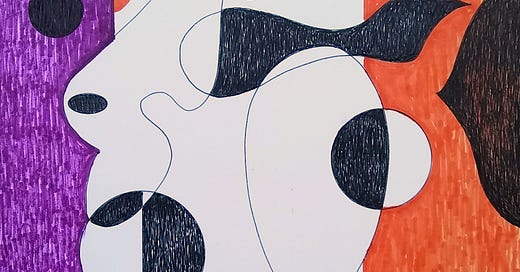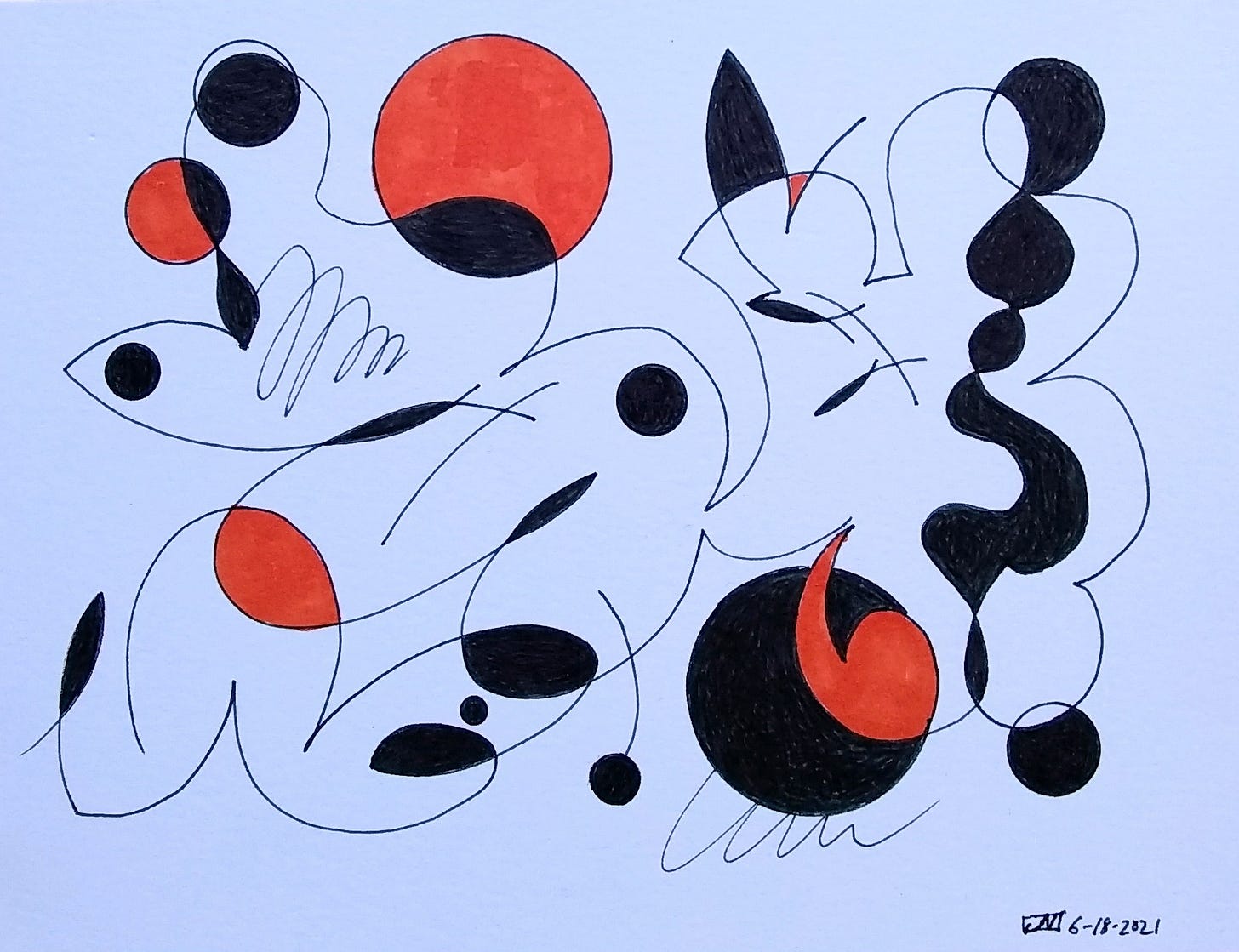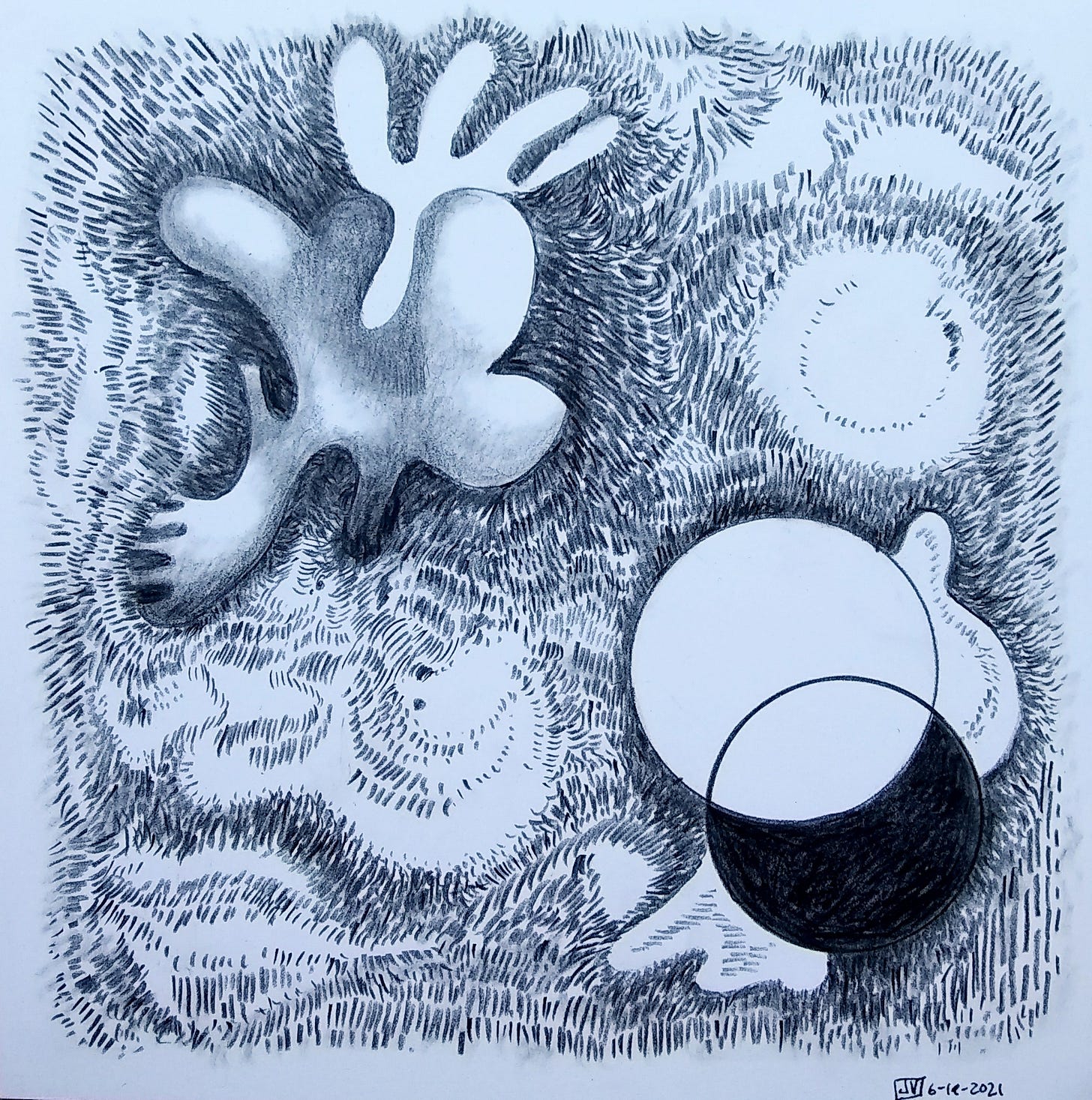Happy Juneteenth, everyone. This is my 20th Eulipion Outpost issue.
ART
Virtually all my new work appears on my Instagram page soon after completion. I post older works less often—if at all. Well, I’m making a change; from now on, all my new work will be reserved for this newsletter, and I will post only older works (at least a year old) on Instagram.
Below: several improvisatory pieces (doodles, really). They seem to be influenced by mid-century style biomorphic shapes (I’m thinking Calder and Gorky):
The piece below was made with graphite pencil. This one’s pretty strange (in terms of juxtaposition of shapes and composition) and I’m not sure how I feel about it. The lines remind me of magnetic fields made visible with iron filings and magnets. This type of drawing is hard on my hands, though, because I spend the whole time repetitively making these tiny, short strokes. I’m getting the beginnings of arthritis in my fingers and sometimes drawing like this is a bit painful. I’d like to try painting with liquid graphite, which should help. Plus it’ll be fun to try something new.
CHINATOWN
For over six years, I’ve had a leadership role in a local historical and cultural nonprofit based in Salinas Chinatown. In “Stories of Chinatown,” published in Voices of Monterey Bay (May, 2019), I told the story of how I got involved in ACE through my interest in Filipino newspapers.
This year, I’m going through some changes. I’ve resigned as co-chair and board member, and will now focus mostly on program development (i.e., historical exhibits and educational programming). This feels like a big shift for me, but I’m looking forward to returning to what got me involved with this nonprofit in the first place: cultural and historical research.
My VOMB article didn’t mention that, around the 1970s/80s, the neighborhood began slipping into a blighted state. Although its cultural organizations (two tong associations, the Japanese Buddhist temple, the Chinese association, and the Filipino Community Center) remain, the thing that made Chinatown a real community disappeared—virtually all the families moved out of the neighborhood, taking with them their businesses: the small cafes and chop suey houses, bars, pool halls, mom and pop markets, garages, barber shops, hotels, and at least one photography studio. Soon after, people experiencing homelessness, addiction, and other crises, moved in, mostly to be close to the homeless service providers on Soledad St.
Although not often discussed, apparently the re-routing of Hwy 101 past Chinatown, the change from two-way to one-way streets, and the construction of two Southern Pacific Railroad underpasses (one on each side of Chinatown), effectively cut off the neighborhood from downtown Salinas, while making access to Chinatown businesses difficult.
But that story has always seemed vague, colored by rumor, and all mixed up with John Steinbeck’s romantically seedy descriptions of Chinatown’s “odors…of roasting pork and punk and black tobacco,” its prostitutes, and “the deep blatting stroke of the great gong in the Joss House.”
Exactly how did the highway re-routing and underpass construction affect Chinatown? How did the residents respond? Was there resistance? How was the construction reported in the newspapers? How did it play out in City Council meetings? I want to learn more about this.
In the short video below, Prof. Andrew Leong discusses gentrification and how U.S. Chinatowns have been “wiped out by the lack of proper city planning policies.” However, the dispersion of what was once a thriving AAPI community in Salinas did not come from gentrification. The daily community life of Salinas Chinatown was wiped out long before gentrification could happen. Planning policies dispersed the AAPI population, causing them to migrate out to areas where neighborhood enclaves could not form. Nevertheless, the community and organization halls remain, and community members still meet in the old locations. Their members (the few remaining offspring of the neighborhood founders) also hope and plan for a “revitalization” of Chinatown, a return to some semblance of the community they remember. But what form that will take in the future remains to be seen.
FIVE GOOD THINGS
I recently joined the Buddhist Geeks Network. I’ve never been a regular meditator, but I’m exploring that modality again, perhaps even more deeply. I’ve always been a bit geeky and experimental, anyway. I also like their approach to race and social justice and “social meditation” (even though most of that is online for now).
1) A fascinating and lengthy discussion of Lama Rod Owens’ new book Love & Rage with Owens and Buddhist Geeks Founder Vince Fakhoury Horn in the Buddhist Geeks Podcast (see the Jan. 6, 2021 podcast).
2) Ruth King’s calming meditation: “Ungripping the Heart and Mind”:
3) Do you play the ukulele? Ukulele Underground with Jason Arimoto beautifully perform “Little Wing” by Jimi Hendrix. An animated chord diagram accompanies it in real time, so you can play along:
If you DO play ukulele, what’s your favorite song to play and why?
4) I’d like to think I’m fairly realistic about aging. But I know I also retain a lot of learned ideas and stereotypes about being old (or young, for that matter) that are not helpful, and that occasionally affect me negatively. Ageism impacts people of all ages. Check out “No Ageism,” a short film by Ayanna Maia Saulsberry:
5) Found this on BOOOOOOOM! — New Orleans artist Thomas Deaton paints those places where wilderness overtakes us. This art arouses mixed feelings in me, both despair and reassurance. I’m reminded that without the presence of humans, life will go on, and even flourish—and we will one day feed this wildness, even if our corpses are encased in wood, steel, or cement. Eventually nature will take us back.
Thanks for reading my newsletter. See you next week…






